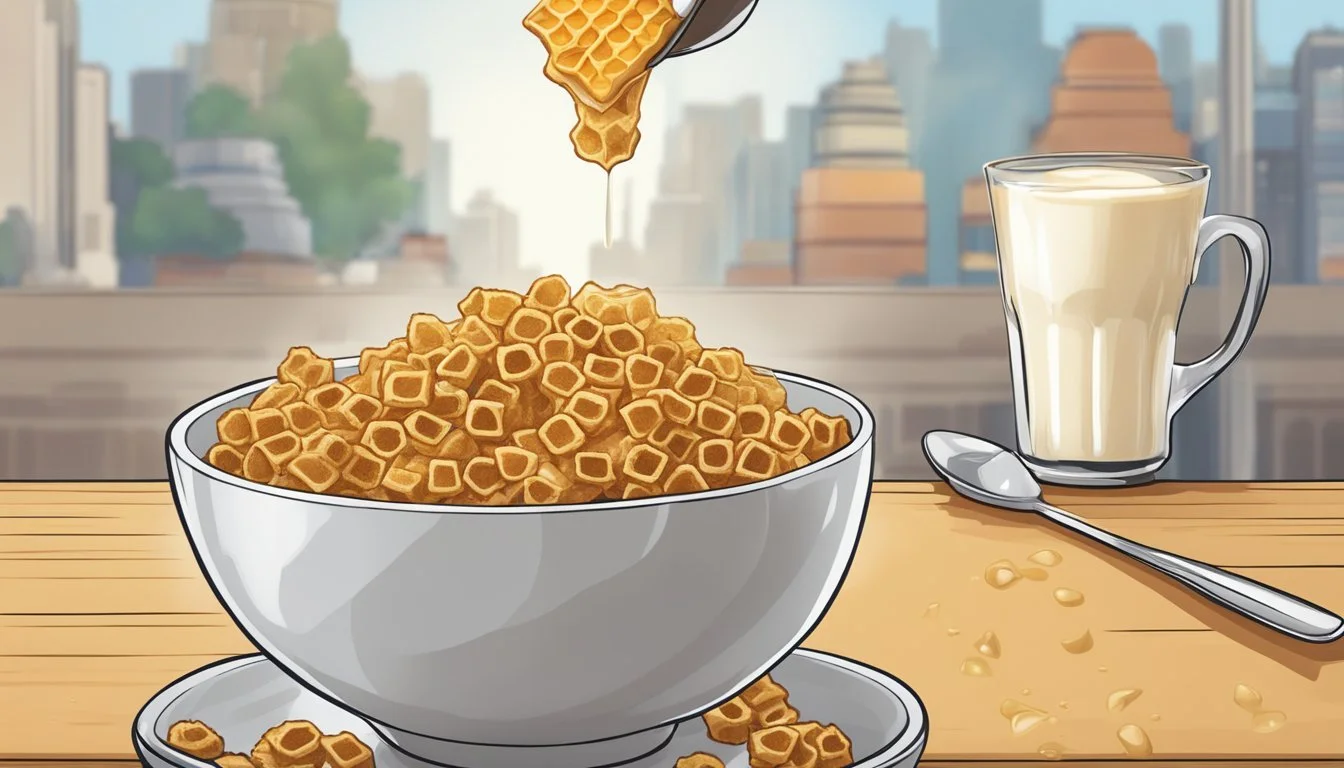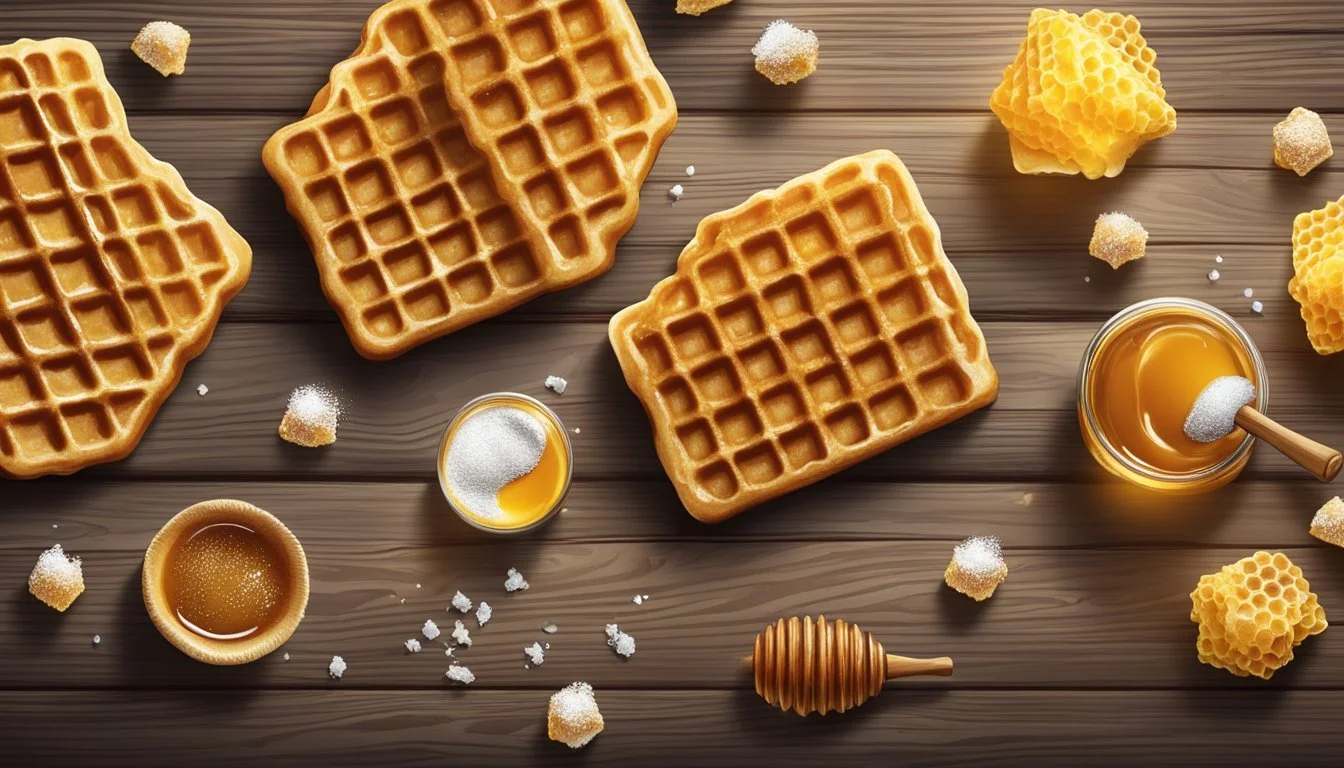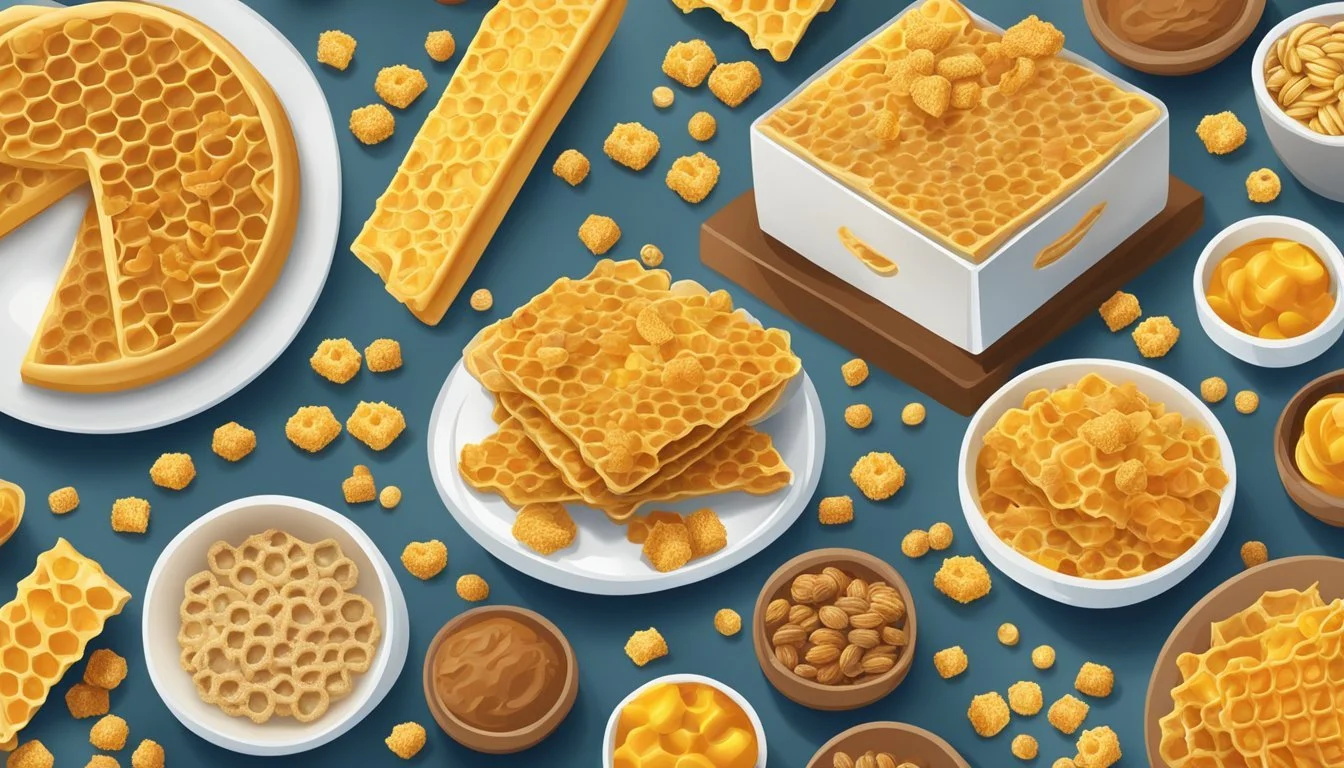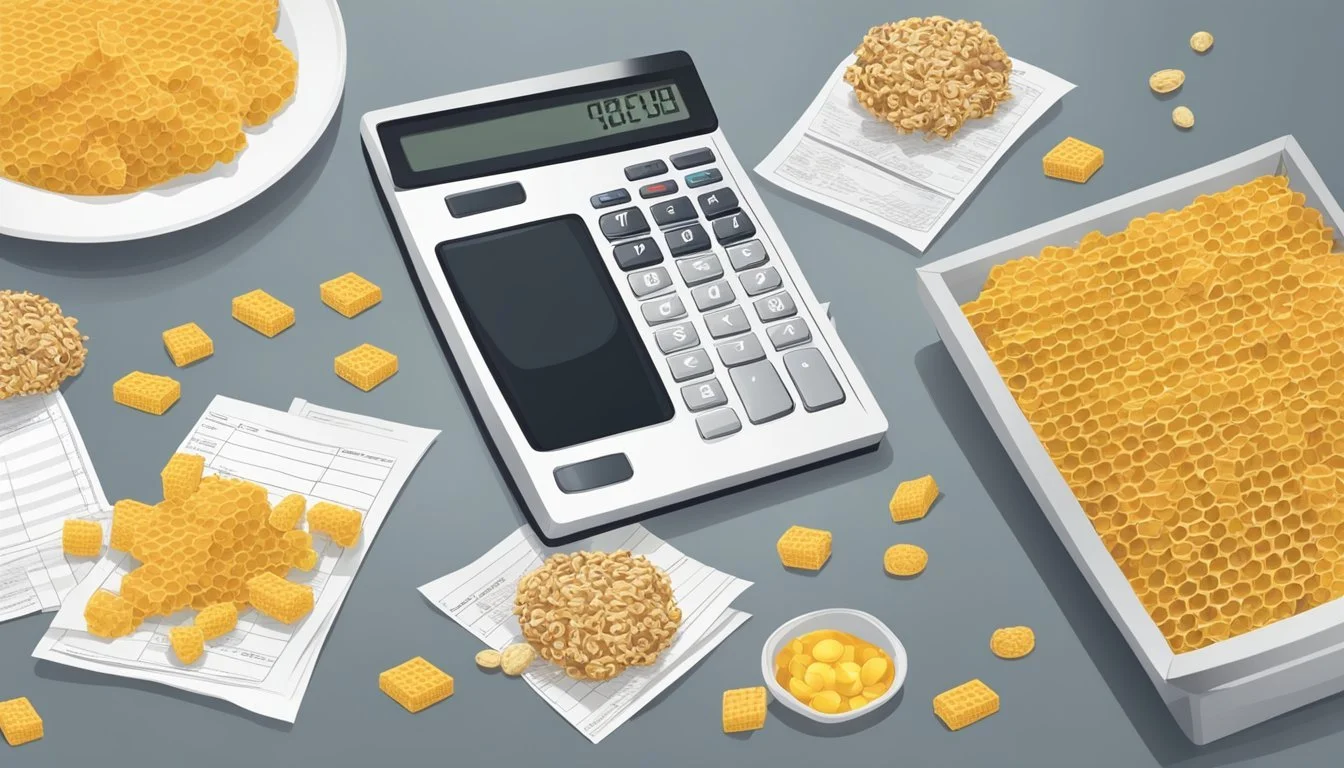Honeycomb vs Waffle Crisp
A Comparative Analysis of Breakfast Cereals
This Article is Part of Our Breakfast Cereal Guide with Details on Honeycomb Nutrition and Waffle Crisp Nutrition
When it comes to breakfast cereals, Honeycomb and Waffle Crisp hold a special place in many pantries. Both of these cereals offer unique flavors and textures that appeal to different taste preferences. Waffle Crisp, with its maple syrup-flavored corn cereal bits, mimics the satisfying crunch of a waffle. Honeycomb, on the other hand, delivers large, airy honey-flavored puffs that promise a light and sweet start to the day.
Nutritionally, Honeycomb and Waffle Crisp offer a variety of vitamins and minerals, but each has its own strengths. Honeycomb is rich in Vitamin D, while Waffle Crisp provides higher levels of essential nutrients like Zinc, Selenium, and Vitamin B12. This makes the choice between these two cereals not just a matter of flavor preference but also nutritional needs.
The intrigue around both cereals lies not only in their taste but also in their nostalgic value. Waffle Crisp has been around since 1996 and continues to be a favorite for those who love the sweet taste of waffles. Honeycomb, with its unique honeycomb-shaped pieces, has been a breakfast staple for even longer. For those seeking a balance of taste, texture, and nutrition, comparing Honeycomb and Waffle Crisp brings an engaging conversation to the breakfast table.
Historical Origins
Honeycomb and Waffle Crisp cereals both have unique backstories that highlight their development and popularization over the years.
Inception of Honeycomb Cereal
Honeycomb cereal was introduced by Post in 1965. Marketed as a cereal with a unique honeycomb shape, it was designed to stand out among other breakfast cereals.
The cereal quickly gained popularity due to its distinct hexagon shape and honey-flavored taste.
Marketed with a variety of engaging advertising campaigns, it found a strong fan base among children and adults alike.
Honeycomb was one of the early examples of cereals ready-to-eat that targeted not only flavor but also an engaging eating experience.
Development of Waffle Crisp
Waffle Crisp was launched by Post in 1996. It featured maple syrup-flavored corn cereal bits designed to mimic the shape and taste of waffles.
The cereal's design aimed to combine familiar breakfast elements—like waffles and syrup—into a convenient, ready-to-eat format.
This appeal to comfort and nostalgia drove its initial popularity.
Waffle Crisp had a square shape with a darker, toasted appearance and sugar crystals, adding to its visual and taste appeal.
Despite its discontinuation in 2018, Waffle Crisp remains a memorable product for many cereal enthusiasts, who often reminisce about its distinctive flavor and texture.
Nutritional Comparison
Both Honeycomb and Waffle Crisp cereals have unique nutritional profiles. This section will explore the caloric values, macronutrient content, and vitamins and minerals in both cereals.
Caloric Values
Honeycomb Cereal and Waffle Crisp differ in caloric content. Honeycomb Cereal typically contains around 150 calories per serving, while Waffle Crisp is slightly lower at 120 calories per serving.
These differences may be due to the variation in ingredient composition and recipe formulations. Consumers monitoring their caloric intake might prefer Waffle Crisp for its slightly lower calorie content.
Macronutrient Content
Both cereals are high in carbohydrates. Honeycomb Cereal has about 35 grams of carbs per serving. Waffle Crisp contains 34 grams of carbs.
In terms of protein, Honeycomb Cereal offers 2 grams per serving, while Waffle Crisp provides a slightly higher amount of 2.5 grams. Fat content is also moderate for both, with Honeycomb having 1.5 grams and Waffle Crisp containing 2 grams per serving.
Fiber content is similar, sitting at around 1 gram per serving in both cereals. This makes them relatively low in dietary fiber compared to other breakfast options.
Vitamins and Minerals Profile
Honeycomb Cereal has a strong profile for Vitamin D, covering 30% of daily needs per serving. It's also fortified with other essential vitamins and minerals.
Waffle Crisp, however, surpasses Honeycomb in several areas. It has more Zinc, Selenium, Phosphorus, Vitamin B12, Vitamin B6, Copper, Iron, and Vitamin A RAE. For instance, Waffle Crisp contains higher amounts of Vitamin A and B-complex vitamins, which are essential for immunity and energy metabolism.
The sodium content in Waffle Crisp is also notable at 220mg, equivalent to 10% of the daily value. In contrast, Honeycomb has a slightly lower sodium level. The higher mineral content may make Waffle Crisp a preferable choice for those needing specific nutrient boosts.
Physical Attributes and Taste Profile
The comparison of Honeycomb and Waffle Crisp involves examining their texture, taste, and appearance closely. Each offers a distinct experience, making this evaluation crucial for cereal enthusiasts.
Texture and Crunch Factor
Honeycomb cereal features a hexagonal pattern that contributes to a light, airy texture. This shape creates a significant crunch when you bite into it, balancing between crisp and slightly chewy.
Waffle Crisp, with its distinctive square waffle shape, offers a denser and more substantial crunch. It has a toasted quality, giving it a firmer texture. Both cereals remain crispy in milk for a reasonable amount of time, but Waffle Crisp tends to hold its crunch longer due to its denser structure.
Flavor Notes
Honeycomb cereal delivers a mild sweetness with subtle honey undertones. This makes it a slightly floral and light cereal, appealing to those who prefer a gentler taste. The honey flavor is natural, not overpowering, providing a pleasant morning start.
Waffle Crisp, on the other hand, has a richer, more sugary taste. The cereal's flavor profile is reminiscent of maple syrup, enhancing its waffle-like qualities. This gives it a more intense and nostalgic taste, perfect for those who love bold, sweet flavors.
Visual and Shape Appeal
Honeycomb cereal stands out with its hexagonal shape, designed to resemble natural honeycomb. This shape not only contributes to its texture but also makes it visually appealing and easily recognizable.
Waffle Crisp is designed to mimic small waffles. Each piece is square-shaped with a grid pattern, closely resembling miniature toasted waffles. The darker, toasted color adds to the visual appeal, making it look particularly appetizing.
In essence, both cereals offer unique shapes and appealing visuals, enhancing the eating experience. Honeycomb's hexagons and Waffle Crisp's tiny waffles each provide a distinctive look that complements their respective textures and flavors.
Cultural and Consumer Perception
Honeycomb and Waffle Crisp have unique positions influenced by their breakfast popularity, branding, marketing strategies, and social media presence. These elements contribute to their status as beloved cereals.
Breakfast Popularity
Honeycomb and Waffle Crisp enjoy significant popularity as breakfast cereals. Honeycomb, known for its large honey-flavored puffs, is loved for its light texture and quick preparation, making it a favorite among families.
Waffle Crisp, with its maple syrup-flavored waffle-shaped pieces, has carved out a loyal consumer base. Despite being discontinued for a period, demand from dedicated fans led to its return, a testament to its enduring appeal.
Branding and Marketing Influence
Post Consumer Brands, the producer of both cereals, utilizes targeted marketing to strengthen their brands. Honeycomb's branding emphasizes nostalgia and simplicity, appealing to those with fond memories of their childhood breakfasts.
Waffle Crisp, similarly, leverages its unique shape and flavor to stand out. The re-launch of Waffle Crisp was met with enthusiasm, driven by effective campaigns highlighting its long-awaited return.
Social Media Presence
Social media platforms like Instagram, Twitter, and Facebook play a significant role in shaping consumer perception of both cereals.
Honeycomb benefits from posts that celebrate its retro appeal, often shared by nostalgic adults. Waffle Crisp's presence is marked by enthusiastic posts from fans celebrating its comeback, showcasing its popularity through viral content and community engagement.
Both cereals maintain a positive presence on social media, with users frequently sharing photos and experiences that highlight their love for these iconic breakfast options.
Consumption Patterns
Understanding the consumption patterns for Honeycomb and Waffle Crisp involves exploring how these cereals are typically served, paired with beverages and foods, and whether they are more commonly enjoyed as snacks or full meals.
Serving Suggestions
Honeycomb:
Honeycomb cereal is usually enjoyed with milk in a bowl. The hexagonal shape of each piece provides an interesting texture. The recommended serving size is often around 1 cup, delivering a satisfying crunch. Toppings such as fresh fruits, like sliced bananas or strawberries, can enhance the flavor.
Waffle Crisp:
For Waffle Crisp, serving it with milk is a popular choice. The cereal captures the essence of a breakfast waffle, making it delightful with syrup or maple syrup drizzled over the top for extra sweetness. A common serving size is also about 1 cup, resembling waffle segments in texture and taste.
Pairing with Beverages and Foods
Honeycomb:
Honeycomb pairs well with cold milk but can also be enjoyed with plant-based milks such as almond or oat milk. This cereal can be paired with a glass of orange juice or enjoyed alongside a cup of coffee or tea for a complete morning routine.
Waffle Crisp:
Waffle Crisp pairs excellently with milk and can be complemented by warm beverages like hot chocolate or coffee. The maple and waffle flavors also marry well with a chilled glass of apple juice or iced tea. It can additionally be served with a side of butter and syrup to mimic a traditional waffle breakfast experience.
Snacking Versus Full Meals
Honeycomb:
Honeycomb is often enjoyed as a full meal in the morning, served with milk and sometimes fruit. It can also be a handy snack due to its lightness and the unique texture that allows it to be consumed dry straight from the box.
Waffle Crisp:
Waffle Crisp tends to be versatile in consumption patterns. It can serve as a substantial breakfast when paired with milk and syrups. Additionally, its sweet, waffle-like flavor makes it a favorable snack for both kids and adults during the day, either dry or with milk. The familiar taste of waffles in a cereal form provides comfort and enjoyment in different settings.
Understanding these patterns can help consumers make informed choices about how to enjoy Honeycomb and Waffle Crisp, whether for breakfast or as a snack throughout the day.
Dietary Considerations
When comparing Honeycomb and Waffle Crisp cereals, it's essential to understand their dietary implications, especially for individuals with specific nutritional needs or restrictions.
Suitability in Various Diets
Honeycomb and Waffle Crisp cereals have distinct characteristics in terms of dietary suitability. Honeycomb offers slightly lower calorie content per serving, making it a favorable option for those on a low-calorie diet. Waffle Crisp, with higher levels of essential vitamins and minerals such as Vitamin B12, Zinc, and Selenium, may be more beneficial for individuals needing these nutrients.
For those on a low-fat diet, both cereals are relatively low in fat, with Waffle Crisp containing 2g of total fat per cup and Honeycomb at a similar level. Considering low-carb diets, neither cereal is ideal since they both contain approximately 30-34g of total carbohydrates per serving.
Allergen Information
Allergen considerations are crucial when choosing breakfast cereals. Honeycomb and Waffle Crisp are produced in facilities that handle common allergens. Both cereals contain gluten and may have traces of soy and dairy due to cross-contact during production.
Honeycomb contains high fructose corn syrup and other sweeteners that might pose concerns for individuals with certain dietary sensitivities. On the other hand, Waffle Crisp has ingredients such as wheat flour and corn syrup, which must be taken into account for those with wheat or corn allergies.
It's always recommended to check the packaging for the most comprehensive allergen information and potential cross-contamination warnings.
Health-conscious Alternatives
For health-conscious consumers, considering alternatives is beneficial. Cereals with lower glycemic index values can be better options for maintaining stable blood sugar levels. Plain oatmeal, for instance, is high in fiber and low in sugars, making it a more suitable choice for those on low-glycemic diets.
Another alternative could be cereals made from whole grains with minimal added sugars, such as shredded wheat or bran flakes. These options provide higher dietary fiber content which aids digestion and provides longer-lasting energy without significant spikes in blood sugar levels.
When selecting a healthier alternative, it's important to look for products with low levels of added sugars and whole grain ingredients prominently listed on the label.
Preparation and Variations
Both honeycomb and waffle crisps can be prepared at home or purchased in various commercial forms, each offering unique flavors and textures for enthusiasts.
Homemade Recipes
Honeycomb crisps are typically made using a combination of sugar, golden syrup, and bicarbonate of soda. The mixture is heated until it reaches a caramelized state, then rapidly mixed with bicarbonate to create a foamy texture. Once cooled, it results in a crunchy, airy candy.
Waffle crisps require a waffle iron or waffle maker. The basic batter includes flour, eggs, sugar, vanilla extract, and baking powder. Various flavors and additions like oats, cinnamon, or even chocolate chips can be incorporated.
Waffles are usually light and fluffy, with distinct grid patterns formed by the iron. For a crispier texture, the batter can be modified with extra egg whites.
Commercial Variants and Flavors
Commercial honeycomb crisps often come in bars or pieces, sometimes coated in chocolate or flavored with additional vanilla or cinnamon.
Waffle crisp cereals are popular, especially among children. Brands often market these as crunchy, waffle-shaped pieces that retain their crispness in milk.
Flavored versions include maple syrup, chocolate, and blueberry. Companies also produce make-ahead, frozen waffle crisps that can be toasted or microwaved for convenience.
The variations and accessibility of these treats make both honeycomb and waffle crisps unique and favored by many.
Economic Considerations
When comparing Honeycomb and Waffle Crisp cereals, it is essential to examine their economic aspects, which include price and value, as well as availability and distribution. These factors can significantly influence consumer decisions.
Price and Value
Honeycomb and Waffle Crisp are both produced by Post Consumer Brands, but they vary in price and value.
Honeycomb Cereal is typically priced at around $3.50 to $4.00 per box, depending on the size and retailer. This cereal often comes in larger boxes, providing more servings per purchase, which can be an advantage for families looking for a budget-friendly option.
Waffle Crisp, on the other hand, is priced slightly higher, usually between $4.00 and $4.50 per box. Despite the higher price tag, many consumers consider it worth the cost due to its unique flavor and nostalgic appeal. The smaller box sizes and limited promotional offers can make it a bit more expensive per serving compared to Honeycomb.
Availability and Distribution
The distribution and availability of Honeycomb and Waffle Crisp cereals also play a crucial role.
Honeycomb Cereal is widely available across various grocery stores, supermarkets, and online platforms. It enjoys broad distribution, making it easier for consumers to find in multiple regions. Additionally, Honeycomb frequently appears in promotional deals and bulk buying options, adding to its convenience.
Waffle Crisp, in contrast, has a more limited distribution. It is often found in specialized aisles or select stores, increasing the challenge for consumers to locate it. Furthermore, its availability can fluctuate, sometimes making it a rare find. While it is also available online, the shipping cost can add to the overall expense.
In summary, while Honeycomb offers broader availability and generally lower prices, Waffle Crisp stands out for its distinct taste, despite being higher-priced and less widely distributed.








